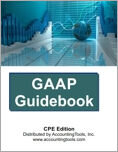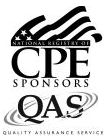GAAP Guidebook (CPE Course)
CPE Credit: 29 hours
Course Type: Downloaded PDF materials with online test
Price (with PDF Textbook): $200
Course Description
Generally Accepted Accounting Principles (GAAP) are used as the basis for financial reporting. The original GAAP documents span thousands of pages, and so are difficult to research. The GAAP Guidebook solves this problem by condensing GAAP into a single volume. This course describes the key elements of each topic, how accounting information is disclosed, and where to look in the FASB Codification source documents for additional information. The text contains hundreds of practical examples that show how to apply GAAP to real-world situations, as well as sample journal entries and usage tips. In short, the GAAP Guidebook serves as a handy reference for accountants who need quick answers to difficult problems.
Author: Steven Bragg
Course Number: AC1095
Table of Contents (general topic areas)
Part 1. Presentation of Financial Information (13 chapters)
Part 2. Assets (7 chapters)
Part 3. Liabilities and Equity (8 chapters)
Part 4. Revenue and Expenses (7 chapters)
Part 5. Broad Transactions (11 chapters)
Learning Objectives
Cite the accounting principles that underlie Generally Accepted Accounting Principles.
Specify the transactions related to discontinued operations, as well as the disclosures required for certain accounting transactions.
Identify the account classifications used in the balance sheet, as well as the structure of the balance sheet.
State the transactions included in and excluded from other comprehensive income.
Specify the different formats in which the income statement can be presented.
Cite the contents of the sections of the statement of cash flows, and the differences in presentation for the different types of statements of cash flows.
Recognize the disclosures required by the Securities and Exchange Commission
Identify the situations in which accounting changes are allowed, and note the mechanics of retrospective application of changes.
State the methods used to derive current cost.
Specify the calculations for basic earnings per share and diluted earnings per share.
Identify the assumptions that underlie the integral view and discrete view of interim reporting.
Recognize the situations that can cause reportable risks and uncertainties.
State the segment test rules used to determine reportable segments.
Specify the accounting treatment for lending arrangements and loan origination fees.
Identify how investment securities are measured and how to account for associated credit losses.
Recognize how the equity method is formulated and updated.
Cite how the periodic and perpetual inventory methods are used to derive the cost of goods sold, and how the gross profit method and retail method are used to estimate ending inventory.
Recognize the rules for recognizing and disclosing deferred advertising costs, as well as the accounting for insurance contracts.
Identify the situations in which goodwill is associated with reporting units, and note the rules for conducting impairment testing.
Specify the valuation method used for acquired fixed assets, as well as the calculations for the various depreciation methods.
Identify the assessments and surcharges associated with insurance activities.
State the accounting rules for deferring and recognizing asset retirement obligations.
Specify the circumstances under which the cost of employee and other contractual terminations can be recognized.
Cite the characteristics of and reporting obligations associated with commitments.
State the circumstances under which loss contingencies are recognized, and when they are only disclosed.
Identify the methods used to place valuations on guarantees.
State the components of debt, as well as the circumstances under which a debt arrangement is considered to be a troubled debt restructuring.
Specify the circumstances under which a spinoff occurs, and when a dividend is in arrears.
Identify the evaluation criteria for a contract, the components of the transaction price, and when a contract modification triggers treatment as a new contract.
Recognize the circumstances under which the costs of compensated absences are recognized.
State the key elements of net periodic pension cost, and the accounting for defined benefit and defined contribution plans.
Specify how costs are derived for exercised and unexercised stock options.
Identify the proper expense recognition for insurance contracts and business process reengineering.
State the types of activities classified as research and development, and how research and development costs are to be recognized.
Recognize which tax rate to apply to a reporting period.
Identify the types of acquisitions, and the types of intangible assets that can be recognized as part of an acquisition.
Identify the situations in which a controlling financial interest cannot be determined, as well as the types of eliminations used when conducting a consolidation.
Specify the accounting for derivative speculation and the classifications for hedges and investments. Recognize the methods used to measure hedge effectiveness.
State the concepts upon which fair value measurements are derived.
Cite the circumstances in which the fair value option can be applied, and the disclosures related to financial instruments.
Specify the accounting for payments to suppliers in foreign currencies, as well as how to identify a functional currency.
Identify the situations in which interest capitalization can be used, and when an interest rate should be imputed.
Specify the leasing rules related to asset substitution.
Recall the circumstances under which a separate lease component is considered to exist.
Specify the different types of lease payments.
Recall how the 12-month lease exception works.
Identify the unique characteristics of sales-type and direct financing leases.
Specify the restrictions on the use of the risk-free discount rate when deriving a lease present value.
Specify the valuation alternatives in a nonmonetary exchange, and the usage rules for boot.
Cite the types of entities considered to be related parties, and what information should be disclosed about them.
State the types of events classified as subsequent events, and note which of these events can alter the financial statements.
Level: Overview
Instructional Method: QAS Self-Study
NASBA Category: Accounting
Prerequisites: General knowledge of transactional accounting and the construction of financial statements.
Advance Preparation: None
Latest Review Date: November 2024
Program Registration Requirements: Click on "Purchase Course" near the top of this page to pay for and access the course. You will then be able to download the course as a PDF file, then take an on-line examination, and then download a certificate of completion if you pass the examination.
Program Refund Policy: For more information regarding administrative policies concerning complaints, refunds, and other matters, see our policies page.
AccountingTools, Inc. is registered with the National Association of State Boards of Accountancy (NASBA) as a sponsor of continuing professional education on the National Registry of CPE Sponsors. State boards of accountancy have the final authority on the acceptance of individual courses for CPE credit. Complaints regarding registered sponsors may be submitted to the National Registry of CPE Sponsors through its website: www.nasbaregistry.org.
The NASBA sponsor identification number for Accountingtools, Inc. is 115881.
AccountingTools is an IRS Approved Continuing Education Provider. We are compliant with the requirements for continuing education providers (as described in sections 10.6 and 10.9 of the Department of Treasury’s Circular No. 230 and in other IRS guidance, forms, and instructions). Our IRS Approved Continuing Education Provider number is 72821.


